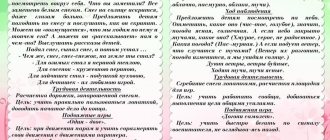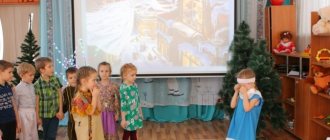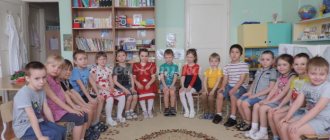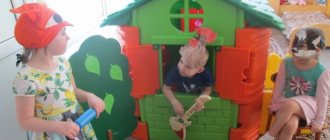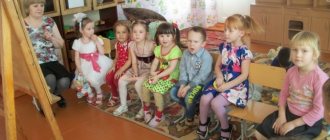Theater day in kindergarten. Middle group
Thematic day “WORLD THEATER DAY” for children 4-5 years old
Goal: Development of children's communication abilities through theatrical and play activities Objectives: To promote the development of the child's individual creative abilities and artistic inclinations; Arouse in children a sustainable interest in the theater; Cultivate friendly communication with each other; To form a sustainable interest in literature in children; Involve children in telling fairy tales Planning: 1. Conversation about the theater 2. Table theater “Mashenka and the Bear” 3. Physical exercise “We are in the theater of animals” 4. Game - concert “On the theater stage...” 5. Didactic game “Collect a fairy tale” 6 Showing the play by parents “Sister Alyonushka and Brother Ivanushka” 7. Drawing “My Favorite Fairy Tale” (joint creativity of parents with children) MORNING 1. CONVERSATION ABOUT THE THEATER Educator: There is a stage and backstage, And actors and actresses, There is a playbill and an intermission , Scenery, sold out. And, of course, the premiere! You probably guessed it... (theater)
- Today is World Theater Day.
- What is theater? (children's answers)
- What professions do people work in the theater?
(children's answers)
- Today you and I will be both actors and spectators.
I suggest you go to a fairy-tale place called “Theater”. — In order for you and me to go to the performance, we need to buy tickets. — Why do you need tickets at the theater? (children's answers) Children go to the ticket office and buy tickets.
— Before going to the auditorium, you need to remember the rules of behavior in the theater.
(children's answers)
- Listen, we are invited by a theater bell into the auditorium.
You need to have time to take your seats in the auditorium. — There are three bells in total in the theater before the start of the performance. The third bell indicates that the performance is beginning. After the third bell, the lights in the auditorium go out. It is indecent to enter the auditorium after the third bell. — Prepare your tickets and look carefully at what is indicated on the ticket? (children's answers) Children take seats in the auditorium.
The third bell rings. - Today we will see the premiere of the fairy tale “Mashenka and the Bear”, because today the actors are on stage for the first time.
2. TABLE THEATER “MASHENKA AND THE BEAR” Actors - children
- Did you like the fairy tale?
Did you like the acting? (children's answers) The bell rings.
“I suggest you rest a little.”
Now a short break has been announced, and it is called INTRACT. During intermission, all spectators usually go out into the theater foyer. At this time, you can go to the BUFFET, clean up in the toilet room, and also get acquainted with various photographs of theater artists that are hung on the walls of the foyer. - Today is an unusual day in the theater and therefore you and I can turn into fairy-tale animals... 3. PHYSICAL MOMENT “WILD ANIMALS” On a hot day, along a forest path, the animals walked to a watering hole. (Children walk in a circle, one after another)
A moose calf stomped behind the mother elk,
(They walk, stomping loudly)
A little fox crept behind the mother fox,
(They walk stealthily)
A hedgehog rolled behind the mother hedgehog,
(They move in a deep squat)
Behind the mother bear a bear cub was walking,
(They move in a deep squat)
The squirrel cubs were galloping after the mother squirrel,
(They were jumping on their toes, with their arms bent in front of the chest)
Behind the mother-hare were slanting hares,
(They were jumping, making “ears” from their palms)
The she-wolf led the wolf cubs.
(Walk on all fours)
All mothers and children want to get drunk.
(They walk on all fours) The bell rings.
Children take place in the auditorium. The third bell rings. 4. GAME - CONCERT “ON THE THEATER STAGE...”
Children optional: read poetry, sing songs, dance. Educator: - Our stay in the fairy-tale land called “Theater” has ended. — Did you like it at the theater? (children's answers)
- I suggest thanking all the actors for their wonderful performance with applause and giving flowers.
- What new did you learn? - What do you remember? - What new words did you meet, etc. 5. DIDACTICAL GAME “ASSEMBLE A FAIRY TALE” Children collect puzzles, call the name of the fairy tale from the assembled picture
EVENING 6. SHOW OF THE PERFORMANCE BY PARENTS “SISTER ALENUSHKA AND BROTHER IVANUSHKA”
Parents are actors, children are participants
7. DRAWING “MY FAVORITE FAIRY TALE”
(joint creativity of parents with kids)
Material used: • https://nsportal.ru/detskiy-sad/raznoe/2017/03/05/beseda-s-detmi-sredney-gruppy-chto-takoe-teatr • https://infourok.ru/poznavatelnoe- zanyatiya-na-temu-den-teatra-1298084.html • https://ucthat-v-skole.ru/biblioteka/fizkultminutki/219-zhivotnykh
We recommend watching:
Thematic day in the middle group “Visiting a fairy tale.” Thematic day in kindergarten in the middle group. Samodelkin Day Theater day in kindergarten. Entertainment scenario for children of the senior group Thematic theatrical day in kindergarten in the middle group. Topic: Fairy tales
Similar articles:
Thematic days in the middle group on a winter theme
Conversation with children of the middle group “What is theater?” material (middle group) on the topic
Conversation with preschool children
“What is theater?”
Goal: to expand children’s ideas about the world of theater, about theatrical professions, to stimulate their interest in theatrical art, to enrich children’s vocabulary with theatrical terms.
Equipment: illustrations of the theater premises, theater poster, theater tickets, theater programs, slides with views of various theaters, photographs of actors, fragments of various performances, didactic game “Theater Professions,” dummies of vegetables and fruits, artificial flowers, attributes for the game “Barbershop.”
Educator: Do you know what theater is, what “theater art” means, what professions people work in the theater? (children’s answers).
Theater - the art of the stage - was born in ancient times. The word THEATER came to us from the Greek language and means “place for spectacle, spectacle.” But theater is not only an art form, but also a building where we come to performances.
Want to take a tour of the theater? (Illustrations of various theater buildings are exhibited).
Here is a house, big, beautiful, elegant, old. This is the theater building. Look, in front of him is a colorful, bright poster - a theater poster, which, using drawings, photographs and various words, contains information about upcoming performances in the theater (author of the play, director, actors who play the main roles, title, date and time of the performance). Let's go into this beautiful house. Where have we ended up? Look, we see a small window on which is written “Theater Box Office”.
Come to the window
Give him the money.
And a little window in response
Gives you a ticket.
A theater box office is a place where tickets for theater performances are sold. They contain the name of the theater, the name of the performance, its author, the date and beginning of the performance, as well as the place and row in the auditorium. A cashier sells tickets at the theater box office. Upon entering the theater, the ticket attendant checks the spectators' tickets. A theater performance usually takes a long time, more than an hour. It will be uncomfortable for spectators to sit in outerwear. What should I do? Where should viewers go first? (Children's answers). In the theater, the locker room is called a wardrobe, and the profession of the person who accepts the audience's outerwear is a cloakroom attendant. The cloakroom attendant gives you a number, you clean yourself up and move on.
Are you interested in knowing what today's performance will be about, what actors will play in it? Then you and I simply need to purchase a theater program from the theater employee, the usher. Look, it indicates the characters (heroes) of the play, as well as the names of the actors who play the roles of these characters. The program may also contain a brief description of the performance.
So, you and I are spectators. The performance will begin soon and it’s time for us to go to the auditorium. But what is it? Which of you is the most attentive and heard an unusual sound? This is a theatrical call. In total, the theater rings three bells before the start of the performance. The third bell indicates that the performance is beginning. After the third ring, the lights in the hall go out. It is indecent to enter the auditorium after the third bell. Before the third bell rings, let's take a closer look at the auditorium. This is the largest room of the theater. Take a closer look, do you like it? What makes an auditorium beautiful? (Walls, lamps, in the center of the ceiling there is a huge chandelier). Do you have chandeliers at home? Are they the same as this one? (Children's answers). This chandelier is very large, as the auditorium itself is huge. When the performance begins, this chandelier will go out, darkness will fall in the auditorium, and special spotlights will illuminate the stage. Soffits are special lamps in the auditorium that illuminate the stage from the front and above. With the help of spotlights, lighting designers can depict sunrise or sunset, flashes of lightning, starry skies and much more on stage.
Let's take our seats in the auditorium. How to do it? (See what is indicated on the ticket). The seat you should sit in is indicated on your theater ticket. Parterre - front, bottom rows, amphitheater - top, back. If you are sitting far from the stage, you will need theater binoculars, which you can bring with you or purchase from the cloakroom.
Let's take a look at our auditorium. The most important place in the auditorium is the stage on which the performance is performed. The scene itself is not yet visible. It is still closed with a curtain. A theater curtain is a piece of cloth that covers the stage from the audience. Curtains are made of thick, dyed fabric, folded and decorated with theater emblems or wide fringe sewn to the bottom of the curtain. The performance will begin as soon as the curtain rises or moves apart, as they are sliding or rising.
Many performances in theaters are accompanied by music. Where do you think the musicians sit, is it really on the stage? (Children's answers). The orchestra pit is a special room for the orchestra in the theater, located in front of the stage.
Before the audience can see the performance, people of different professions prepare it for a long time. Let's list them and try not to forget anyone! (Theater professions)
• The scenery for the performance is made in the painting and decoration workshop according to the sketches of the decorative artists.
• Prop - fake, specially made objects of sculpture, furniture, dishes, used in theatrical performances instead of real things. A theater worker who makes props is called a prop maker.
(The teacher shows the children fake things as examples: dummies of vegetables and fruits, artificial flowers, etc.).
• The sound for the performance - the phonogram - is prepared by the sound engineer. During the performance, he can turn on any soundtrack: the sound of rain or the roar of waves, the roar of the crowd or the whistle of the wind.
• Actors for a performance may need a variety of costumes: ancient and modern, fairy-tale and ordinary. The profession of a person who sews and makes suits is called a “costumer.”
• Before the performance, the make-up artist applies makeup to the actors. An experienced make-up artist can change an actor's face beyond recognition.
• The director chooses which play to stage, assigns roles, organizes and conducts rehearsals and everything that happens on stage.
• An actor is a person who plays a role in a play.
• A person who monitors the progress of the performance, the performance of the actors, and can, if necessary, suggest the words of the role to the actors - a prompter.
• A person who leads (conducts) an orchestra of musicians is called a conductor.
A didactic game “Theater Professions” is being held
Today our performance is on stage for the first time, so today is the premiere of this performance. So, the first act (part) of the play began.
(Children are invited to look at the illustrations of any children's performance or watch a video).
Are you tired, do you like our performance? The actors play wonderfully! Do you think they need to rest and prepare for the continuation of the performance?
(Children's answers).
The break between the actions of the play is called intermission. During intermission, all spectators usually go out into the theater foyer. At this time, you can go to the buffet, clean up in the toilet room, and also get acquainted with various photographs of theater artists that are hung on the walls of the foyer.
(Children look at photographs of Perm theater artists and excerpts from the performances in which they played).
Our performance has come to an end. Did you like him? How can we express this without words? Should I thank the actors for their wonderful performance? That's right, applause! Applause is a form of expressing gratitude to artists. If you liked the acting, give it a round of applause! You can also give them flowers.
Educator: We learned a lot of interesting things about the theater today. But there is a special place in it, which is called the mysterious word “backstage” - what is behind the stage. Today we were allowed to visit there with you. You can find a lot of interesting things here. The audience does not see this space. The actors and employees of the theater have their own entrance from the street, leading directly to the stage. Let's get acquainted with the premises of the “backstage kingdom”.
(The teacher lists these rooms and explains their purpose: decorator and props workshop, costume room, actors’ dressing room).
Educator: let us go into one of these rooms. Look, a table! Is he wearing a mirror, paints, powder, makeup, wigs? What kind of room is this? (Children's answers). That's right, this is the actors' dressing room. Let's now play actors and make-up artists, make princesses out of girls, and grandfathers out of boys.
(Children distribute the roles of make-up artists and actors among themselves and the transformations begin before everyone’s eyes)
The children then “return” back to kindergarten.
Summarizing:
Educator: What new did you learn? What surprised you the most? What did you remember? What new words did you meet, etc.
